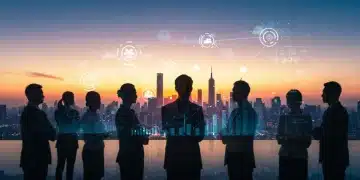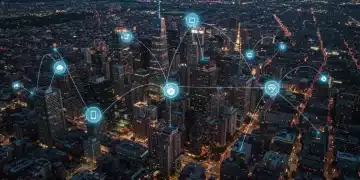Future of Work: 5 Technologies Redefining US Jobs by 2030

Five pivotal technologies including AI, automation, VR/AR, blockchain, and biotechnology are poised to significantly reshape the US employment landscape by 2030, potentially affecting 15% of current jobs and demanding new skill sets.
The landscape of American employment stands on the precipice of a profound transformation. By 2030, it is projected that 15% of US jobs will be significantly redefined or displaced by emerging technologies. This shift underscores a critical period for workers and industries alike, as the Future of Work: 5 Technologies Expected to Redefine US Employment by 2030, Affecting 15% of Jobs moves from theoretical discussion to imminent reality.
Artificial Intelligence and Machine Learning: The Cognitive Revolution
Artificial Intelligence (AI) and Machine Learning (ML) are at the forefront of this technological revolution, rapidly integrating into various sectors. These technologies are not merely automating repetitive tasks but are also enhancing decision-making processes and enabling new forms of data analysis, leading to unprecedented efficiencies and capabilities across industries.
The impact of AI and ML extends beyond simple task automation. They are creating entirely new job categories while simultaneously altering the skill requirements for existing roles. Workers are now expected to collaborate with AI systems, requiring a blend of technical acumen and critical thinking.
AI’s Expanding Footprint in Industries
AI is increasingly pervasive, from healthcare diagnostics to financial trading algorithms. Its ability to process vast amounts of data and identify patterns with speed and accuracy far surpasses human capabilities, leading to more informed and rapid operational decisions.
- Healthcare: AI assists in disease diagnosis, drug discovery, and personalized treatment plans, enhancing patient care.
- Finance: Algorithmic trading, fraud detection, and personalized financial advice are now largely AI-driven.
- Manufacturing: Predictive maintenance, quality control, and supply chain optimization benefit significantly from AI integration.
- Customer Service: AI-powered chatbots and virtual assistants handle routine inquiries, freeing human agents for complex issues.
As AI tools become more sophisticated, the demand for professionals skilled in AI development, ethical AI deployment, and AI system management is surging. This shift necessitates a significant investment in upskilling and reskilling the current workforce to meet these evolving demands.
Advanced Robotics and Automation: Transforming Physical Labor
Advanced robotics and automation are fundamentally reshaping industries that rely heavily on physical labor, including manufacturing, logistics, and agriculture. These technologies are improving productivity, reducing costs, and enhancing safety in environments previously characterized by manual, often hazardous, tasks. The integration of robots, from sophisticated industrial arms to autonomous delivery vehicles, marks a significant stride towards fully automated operational workflows.
The evolution of robotics has moved beyond simple, repetitive actions. Modern robots are equipped with advanced sensors, machine vision, and AI capabilities, allowing them to perform complex tasks, adapt to changing environments, and even collaborate with human workers. This human-robot collaboration, often referred to as ‘cobots,’ is becoming a cornerstone of future industrial practices.
The Rise of Collaborative Robots (Cobots)
Cobots are designed to work safely alongside humans, augmenting their capabilities rather than entirely replacing them. They handle strenuous or monotonous tasks, allowing human workers to focus on more intricate or creative aspects of their jobs.
- Manufacturing Assembly: Cobots assist in precise assembly tasks, improving efficiency and reducing errors.
- Logistics and Warehousing: Autonomous mobile robots (AMRs) transport goods, optimizing warehouse operations and speed.
- Healthcare Support: Robots assist in surgical procedures, dispense medications, and help with patient transfers, enhancing care delivery.

The widespread adoption of these technologies creates a pressing need for a workforce proficient in robotics programming, maintenance, and oversight. Educational institutions and vocational training programs are adapting to prepare individuals for these new roles, emphasizing skills in mechatronics, systems integration, and human-robot interaction.
Virtual and Augmented Reality (VR/AR): Immersive Work Environments
Virtual Reality (VR) and Augmented Reality (AR) are rapidly moving beyond gaming and entertainment, poised to create immersive and interactive work environments across diverse sectors. These technologies offer novel ways for employees to train, collaborate, and visualize complex data, fundamentally altering traditional work methodologies. From remote assistance to intricate design reviews, VR/AR provides powerful tools for enhanced productivity and innovation.
The deployment of VR/AR devices, such as headsets and smart glasses, is transforming how tasks are performed. For instance, field technicians can receive real-time visual instructions overlaid onto their view of equipment, while architects can walk through virtual models of their designs before construction begins. This level of immersion and contextual information significantly boosts efficiency and reduces errors.
Transformative Applications of VR/AR
The applications of VR and AR in the workplace are expanding, offering solutions for complex challenges and fostering new avenues for collaboration and skill development.
- Training and Simulation: VR provides realistic training environments for high-risk professions like medicine, aviation, and emergency services, reducing real-world dangers.
- Design and Engineering: AR allows engineers and designers to visualize prototypes in 3D, facilitating faster iterations and better product development.
- Remote Collaboration: VR/AR enables geographically dispersed teams to collaborate in shared virtual spaces, enhancing communication and teamwork.
- Field Service and Maintenance: AR overlays digital information onto physical objects, guiding technicians through repair processes step-by-step.
As these technologies mature, the demand for specialists in VR/AR development, content creation, and user experience design will intensify. Companies are also investing in infrastructure to support these immersive environments, further signaling their growing importance in the modern workplace.
Blockchain Technology: Enhancing Trust and Transparency
Blockchain technology, widely known for its role in cryptocurrencies, is now recognized for its broader potential to revolutionize various aspects of business operations by enhancing trust, transparency, and security. Its decentralized and immutable ledger system offers solutions for secure data management, supply chain traceability, and digital identity verification, impacting sectors far beyond finance.
The core innovation of blockchain lies in its ability to create a secure, verifiable record of transactions or data without the need for a central authority. This distributed ledger technology (DLT) minimizes fraud, reduces intermediaries, and streamlines complex processes, leading to significant cost savings and increased operational integrity across interconnected systems.
Key Workplace Applications of Blockchain
Blockchain’s unique attributes make it suitable for a wide range of enterprise applications, fostering new roles and requiring specialized expertise.
- Supply Chain Management: Tracks goods from origin to consumer, ensuring authenticity and ethical sourcing.
- Digital Identity: Provides secure, self-sovereign digital identities, simplifying verification processes and reducing identity theft.
- Smart Contracts: Automates agreements based on predefined conditions, executing them without intermediaries once conditions are met.
- Data Security: Offers enhanced data protection and integrity, particularly for sensitive information in healthcare and finance.
The adoption of blockchain technology is driving demand for blockchain developers, architects, legal experts specializing in smart contracts, and cybersecurity professionals. Understanding the principles of decentralized systems and cryptography is becoming an increasingly valuable skill set in the evolving job market.
Biotechnology and Genomics: Reshaping Health and Agriculture
Biotechnology and genomics are pioneering advancements that are fundamentally reshaping industries related to health, agriculture, and environmental science. These fields leverage biological processes and genetic information to develop innovative products and solutions, from personalized medicine to sustainable food sources. The rapid pace of discovery in genomics, particularly with technologies like CRISPR, promises to unlock unprecedented capabilities.
The convergence of biology and technology is leading to breakthroughs that were once unimaginable. Genetic editing, synthetic biology, and advanced bioinformatics are enabling scientists to manipulate living organisms for specific purposes, creating new therapeutic options, improving crop yields, and developing bio-based materials. This has profound implications for human health, food security, and industrial processes.
Impactful Innovations in Biotech and Genomics
The transformative potential of biotechnology and genomics is evident in several key areas, driving the creation of highly specialized roles.
- Personalized Medicine: Tailoring medical treatments to an individual’s genetic makeup for higher efficacy and fewer side effects.
- Agricultural Enhancement: Developing disease-resistant crops, improving nutritional content, and enhancing sustainable farming practices.
- Bio-manufacturing: Producing sustainable materials, biofuels, and chemicals through biological processes, reducing reliance on fossil fuels.
- Disease Eradication: Gene-editing technologies offering potential cures for genetic disorders and infectious diseases.
The growth in this sector is creating a significant need for bioinformaticians, genetic engineers, molecular biologists, computational biologists, and ethical oversight specialists. Educational pathways are expanding to prepare a workforce capable of navigating the complex scientific and ethical challenges presented by these powerful technologies.
Navigating the Transition: Skills for the Future Workforce
As these five transformative technologies advance, the US workforce faces a critical period of adaptation. The projected 15% job redefinition by 2030 underscores the urgent need for both individuals and organizations to embrace continuous learning and skill development. The future job market will prioritize a blend of technical expertise, soft skills, and adaptability, moving away from purely task-specific roles.
Traditional educational models are already evolving to incorporate these new demands, with a focus on interdisciplinary studies and practical applications. Employers are increasingly investing in internal training programs and partnerships with educational institutions to ensure their workforce remains competitive and relevant in a rapidly changing technological landscape.
Essential Skills for Tomorrow’s Jobs
The skills gap is widening, making it imperative for workers to acquire competencies that complement technological advancements rather than compete with them.
- Digital Literacy: Foundational understanding of various technologies and software.
- Critical Thinking and Problem-Solving: Ability to analyze complex situations and devise innovative solutions.
- Creativity and Innovation: Capacity to generate new ideas and approaches in technology-driven environments.
- Adaptability and Lifelong Learning: Willingness to continuously learn new skills and adjust to changing job roles.
- Emotional Intelligence: Essential for effective collaboration, leadership, and customer interaction in automated environments.
Government initiatives, industry partnerships, and individual proactivity will be crucial in mitigating potential job displacement and ensuring a smooth transition for the workforce. The emphasis will be on creating a resilient and agile talent pool capable of leveraging these new technologies for economic growth and societal benefit.
| Key Technology | Impact on US Employment |
|---|---|
| Artificial Intelligence | Automating cognitive tasks, creating demand for AI specialists and data scientists. |
| Advanced Robotics | Transforming manufacturing and logistics, requiring skills in robotics programming and maintenance. |
| VR/AR | Creating immersive work environments, driving demand for VR/AR developers and content creators. |
| Biotechnology | Innovating health and agriculture, increasing need for bioinformaticians and genetic engineers. |
Frequently Asked Questions About the Future of Work
Projections indicate that approximately 15% of US jobs are expected to be significantly redefined or displaced by emerging technologies by the year 2030. This includes roles altered by automation, AI, and other advanced systems, necessitating adaptation from the workforce.
The primary technologies driving this transformation include Artificial Intelligence (AI) and Machine Learning, Advanced Robotics and Automation, Virtual and Augmented Reality (VR/AR), Blockchain Technology, and Biotechnology and Genomics. Each plays a distinct role in reshaping various industries.
AI will increasingly automate routine cognitive tasks, leading to the creation of new roles focused on AI development, ethical oversight, and data interpretation. Existing roles will require enhanced skills in human-AI collaboration, critical thinking, and advanced data analysis to remain relevant.
Key skills for the future workforce will include advanced digital literacy, critical thinking, complex problem-solving, creativity, adaptability, and emotional intelligence. Continuous learning and upskilling will be crucial for individuals to thrive in technology-driven environments.
No, while some jobs may be displaced, these technological advancements are also creating entirely new industries and job categories. The focus is on job transformation and augmentation, where technology complements human capabilities, leading to increased productivity and new economic opportunities.
Looking Ahead: Preparing for a Transformed Workforce
The ongoing integration of these five pivotal technologies signals a profound and irreversible shift in the US employment landscape. As 2030 approaches, the imperative for proactive adaptation across all sectors is clear. Businesses must invest in reskilling programs, educational institutions must align curricula with future demands, and individuals must embrace a mindset of continuous learning. The coming decade will test the resilience and adaptability of the American workforce, but also presents unparalleled opportunities for innovation and economic growth. Watching how policy makers, industry leaders, and educators collaborate to navigate this transition will be critical in shaping a prosperous future.





